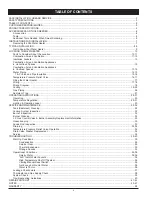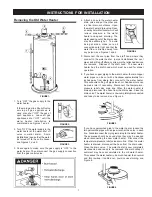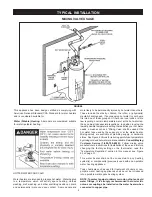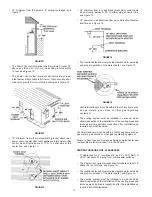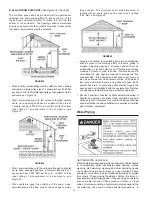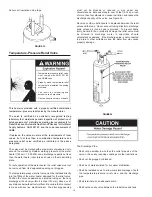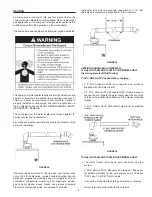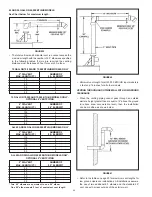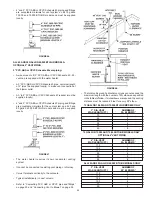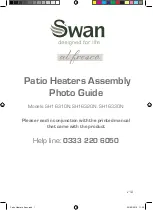
14
B. ALL AIR FROM OUTDOORS:
(See Figures 18, 19 and 20)
The confined space shall be provided with two permanent
openings, one commencing within 12 inches (30 cm) of the
top and one commencing within 12 inches (30 cm) from the
bottom of the enclosure. The openings shall communicate
directly, or by ducts, with the outdoors or spaces (crawl or attic)
that freely communicate with the outdoors.
FIGURE 18.
•
When directly communicating with the outdoors, each opening
shall have a minimum free area of 1 square inch per 4,000 Btu
per hour (5.5 cm
2
/kW) of total input rating of all equipment in the
enclosure, see Figure 18.
•
When communicating with the outdoors through vertical
ducts, each opening shall have a minimum free area of
1 square inch per 4,000 BTU per hour (5.5 cm
2
/kW) of total
input rating of all equipment in the enclosure, see
Figure 19.
FIGURE 19.
•
When communicating with the outdoors through horizontal
ducts, each opening shall have a minimum free area of 1
square inch per 2,000 BTU per hour (11 cm
2
/kW) of total
input rating of all equipment in the enclosure, see
Figure 20.
•
When ducts are used, they shall be of the same cross-
sectional area as the free area of the openings to which
they connect. The minimum short side dimension of
rectangular air ducts shall not be less than 3 inches
(76.2 mm), see Figure 20.
FIGURE 20.
•
Louvers and Grilles: In calculating free area, consideration
shall be given to the blocking effect of louvers, grilles or
screens protecting openings. Screens used shall not be
smaller than 1/4 inch (6.4 mm) mesh. If the free area through
a design of louver or grille is known, it should be used in
calculating the size opening required to provide the free
area specified. If the design and free area is not known, it
may be assumed that wood louvers will be 20-25 percent
free area and metal louvers and grilles will have 60-75
percent free area. Louvers and grilles shall be fixed in the
open position or interlocked with the equipment so that they
are opened automatically during equipment operation.
•
Special Conditions Created by Mechanical Exhausting or
Fireplaces: operation of exhaust fans, ventilation systems,
clothes dryers or fireplaces may create conditions requiring
special attention to avoid unsatisfactory operation of installed
gas utilization equipment.
Water Piping
HOTTER WATER CAN SCALD:
Water heaters are intended to produce hot water. Water heated
to a temperature which will satisfy space heating, clothes
washing, dish washing, cleaning and other sanitizing needs
can scald and permanently injure you upon contact. Some
people are more likely to be permanently injured by hot water
than others. These include the elderly, children, the infirm, or
physically/mentally handicapped. If anyone using hot water in
your home fits into one of these groups or if there is a local
code or state law requiring a certain temperature water at the
hot water tap, then you must take special precautions. In
Summary of Contents for HRN11240P
Page 3: ...3 SAFETY PRECAUTIONS ...
Page 45: ...45 NOTES ...
Page 46: ...46 NOTES ...
Page 47: ...47 NOTES ...




